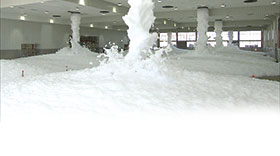

When an insurance company evaluates a business facility, key infrastructure areas are given special attention to reduce the risk in the event of a fire. These include IT equipment, warehousing, substations, archive areas and the like. The next step is to call out a fire specialist to provide advice. This is when terms like ‘fire suppression’ and ‘fire extinguishing’ get bandied about.
So what are the most common terms used and what do they mean, without all the scientific and technical jargon?
Fire protection
This is a broad term that refers to anything relating to the mitigation of unwanted fires. It includes properly designed buildings and the use of appropriate materials, smoke control systems, automatic smoke detectors, passive fire protection (e.g. fireproof coatings etc.), automatic extinguishing systems and so forth.
Fire suppression
The term refers to systems that suppress a fire. The primary aim is to mitigate the spread of fire giving enough time for the fire brigade to arrive. It is a control mechanism to minimise the consequences of a fire. Typically, water-based sprinkler systems fall into this category. Usually these systems are activated when the fire has escalated into a flame. It is typical at this point that sufficient energy is released to raise the temperature of sprinkler bulbs.
Fire detection
These are the systems designed to sense fire. The simplest are the human senses such as smell, touch and sight, which causes someone to raise an alarm. Automatic fire detection includes sensors that are placed around a building waiting for the earliest signs of smoke. Typically, these are those plastic circular devices located on ceilings which are referred to as point type detectors. The most common is an optical point type detector that senses smoke. Others include heat detectors, which either look at how fast the temperature is increasing (rate of rise), or they will trigger at a prescribed temperature set point.
Most manufacturers have sophisticated point type detectors that can sense multiple different phenomena such as a combination of heat and smoke. Some have gone so far as to include audible tones and visual alarms in the detector. Other means of detection, which would require other devices entirely, are air sampling devices, beam detection, linear heat sensing cable, infrared sensing devices, UV sensing devices and so forth. In a nutshell, the term fire detection refers to all of them. The aim of the detection system is to raise an alarm so that persons can evacuate the situation and also to notify the fire brigade if necessary.
Fire extinguishing
This refers to systems that are designed to put out a fire. There are two groups. The first, and most familiar, is handheld equipment such as dry chemical powder extinguishers or CO2 extinguishers. Their proper use requires training.
The second, and perhaps least known, are the automatic extinguishing systems. These include the gaseous fire extinguishing systems that are typically used in data centres, telecoms facilities, archive stores, substations, cable tunnels, museums, ships and so forth. What is important to note is that they are not all the same. There are two families of gases within this group, the inert gas blends and the hydrofluorocarbons. The inert gas types usually consist of argon and nitrogen, two components that already exist in air. They are non-toxic, produce no hazardous by-products, and have no global warming footprint or ozone depleting potential. They are safe to humans, produce no obscuring cloud, and extinguish a fire by starving it of oxygen.
The other class of gases are the hydrofluorocarbons, which are governed by legislation since they are greenhouse gases. The EU has put onerous cradle-to-grave costs on such systems because of their high carbon footprint. HFC227ea has a carbon footprint of 3,5 tonnes, which means 1 kg of it equates to releasing 3,5 tonnes of CO2 into the atmosphere. When putting this into a real application context, a 100 cubic metre server room for example equates to a carbon footprint of 210 tonnes for a non-producing activity. Not very environmentally friendly and could clash with environmental policy. In addition, this family of gases do produce an obscuring cloud on discharge, which could impede someone finding their way to an exit. They can also break down into hazardous by-products such as hydrogen fluoride, which is both toxic to humans and corrosive to equipment. Others break down into Perfluoropropionic acid, which can attack a person’s mucous membranes. Such gases do put out fires, but there are trade-offs that need to be considered.
There is another class of fire extinguishing systems for in-cabinet fire protection using aerosol type extinguishers. These will be covered in another article to be published soon www.facebook.com/astafrica/?ref=settings
| Tel: | +27 11 949 1157 |
| Email: | [email protected] |
| www: | www.astafrica.com |
| Articles: | More information and articles about Alien Systems & Technologies |

© Technews Publishing (Pty) Ltd | All Rights Reserved